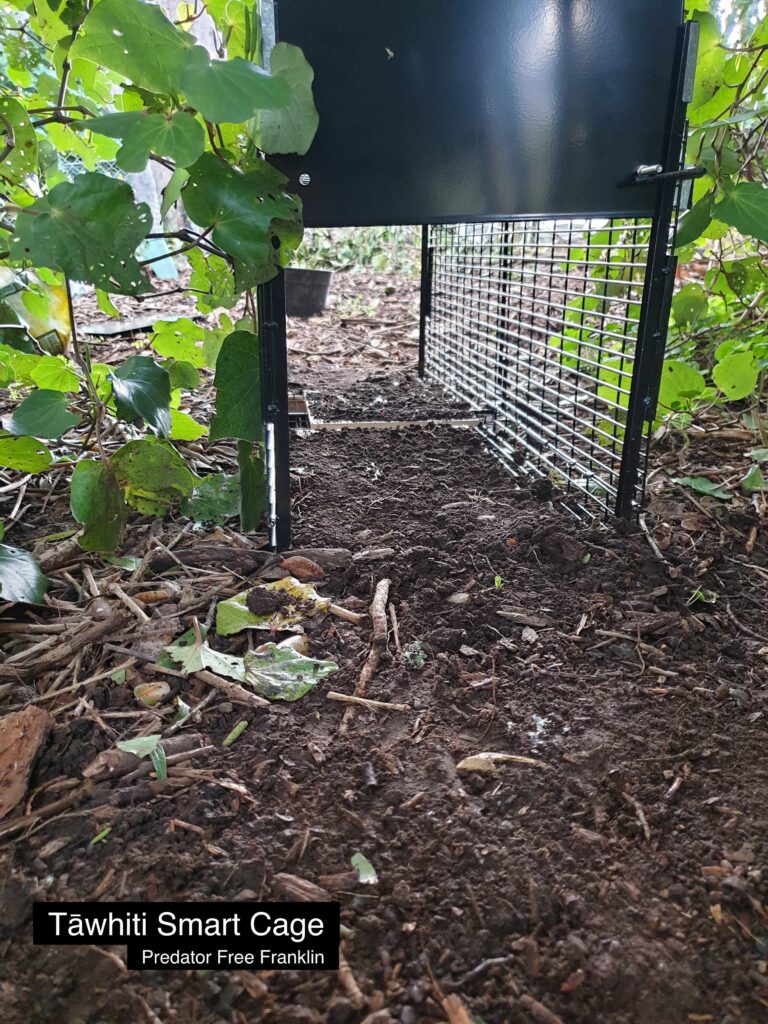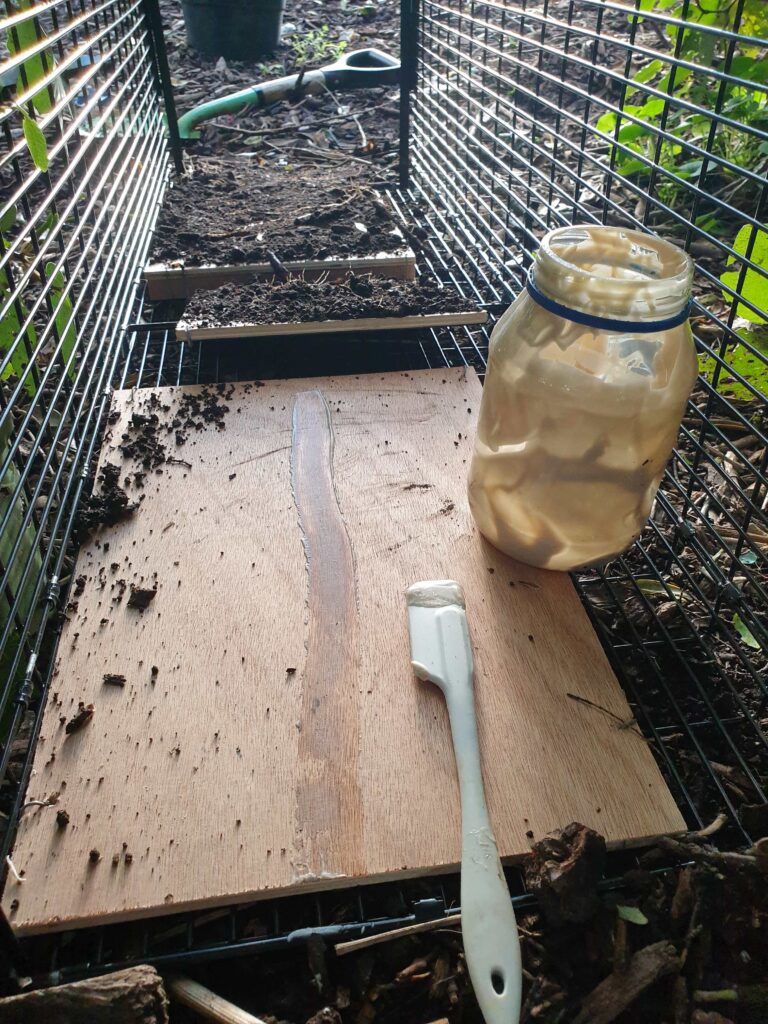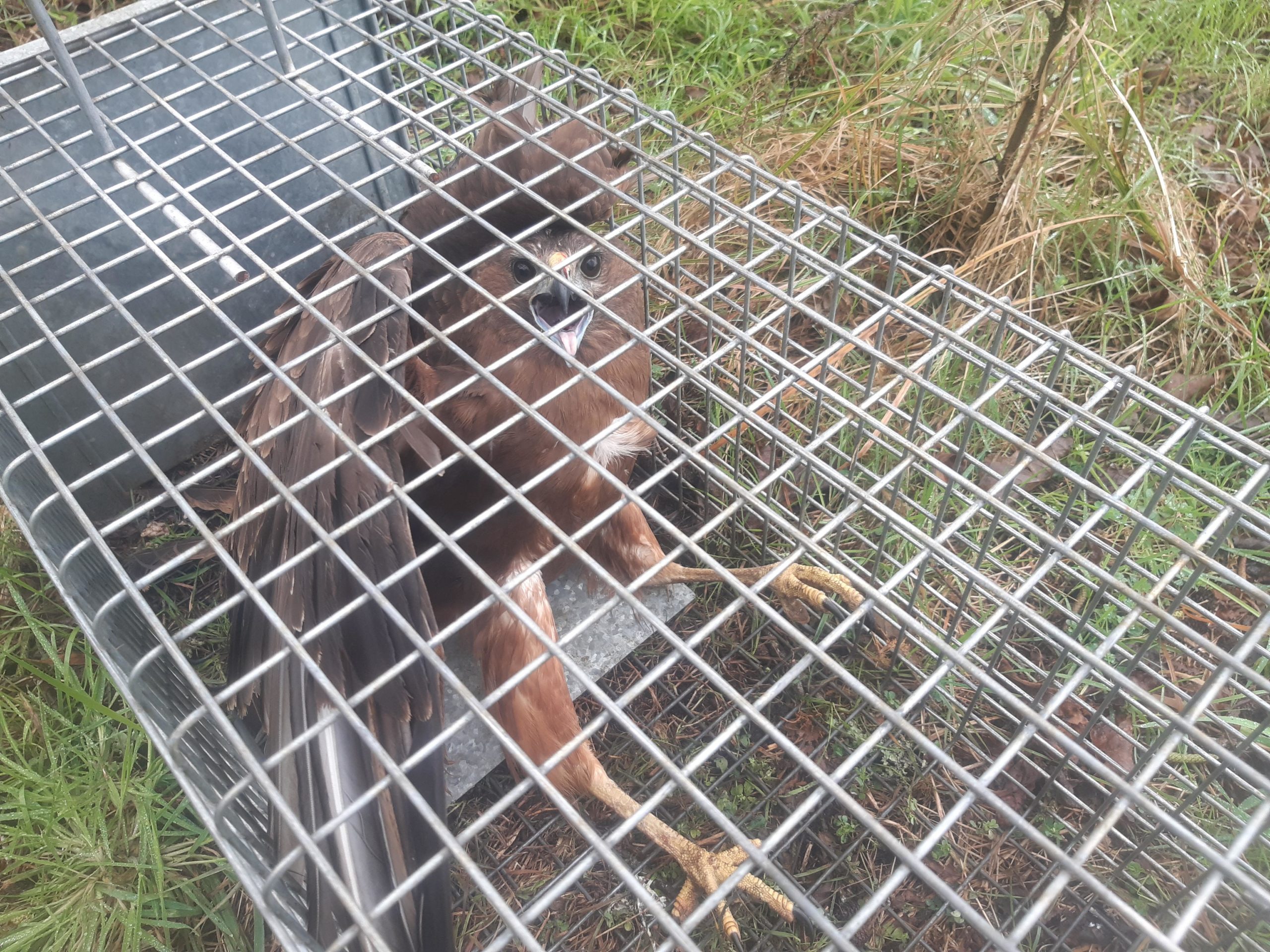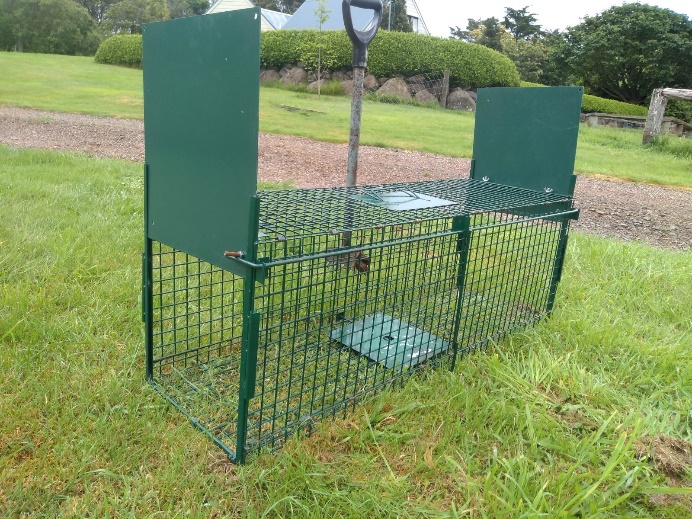Note: There are a lot of tips out there on how to use other types of live catch trap, but these are specific to the “Tāwhiti” – the double-ended smart traps we sell at PFF. If you would like to buy a Tāwhiti trap, please go to our shop.
Why a double-ended live catch trap?
They are very versatile as they can target a wide variety of pest species, including ship rats, Norway rats, possums, feral cats, stoats, ferrets, hedgehogs and rabbits. They are significantly more effective than most kill traps – the large double entrances presents little risk, and the treadle trigger requires only a foot step.
Why a plywood floor?
This has been proven to greatly improve the catch rate of a live catch trap. This is because it is a more natural surface for the pest to walk over than mesh. Also over time it traps and holds the scent of the lure and the scent of the pests that come into the trap. Pests are interested in the scent of other pests, and it is quite common to catch a pest of a different species just the day after after you have caught a stinky mustelid.
Why have a sensor with wireless signalling ?
The sensor detects when the trap has tripped and sends out a wireless signal to Trap.NZ. This notifies the Trap.nz app on your phone and also emails you to tell you which trap has gone off. You can include friends and neighbours in your Trap.NZ setup, so they also receive the message and email. This is a useful way of running a trap on a boundary, where you and a neighbour can take turns emptying it, or for allowing someone to look after your traps when you’re away.
It’s proven that having automatic notifications means people catch more pests. No more walking a trapline in the pouring rain and finding no pests. With an automatic sensor you can check 20 traps at your kitchen table over toast and coffee, and if there’s no catch, you don’t need to go out.
Live capture, remote monitoring and the law.
Note there are strict animal welfare regulations with live capture, and protocols to follow with remote monitoring. Fines for breaches of up to $5,000 for individuals can apply.
Please ensure you have read the following before using the Tāwhiti:
Check Your Sensors Trap.nz app guideline.
MPI Remote Monitoring Systems Guidelines
The Tāwhiti system puts all responsibility on the trap owner to actively* check the trap status daily via Trap.nz or the sensor provider. As a trap owner you must ensure back up is available should you be unavailable to inspect a trap. The trap owner is responsible for managing the communications between trappers assigned to their trap.
* Please do not rely on email notifications – email is not fail safe, and will not notify of a failed sensor (i.e. drained battery etc.)
Using any live capture trap has very specific obligations under the NZ Animal Welfare Act 1999, so please follow the rules below when using a Tāwhiti.
Legal obligations
- You must check every day to confirm that the trap is still on the network (has not lost its signal). A trap can lose signal from a sensor fault or when the sensor battery runs out. If you see a trap has lost its signal, you must go out and check it, or arrange for someone else to check it within 12 hours of sunrise on that day. Please stick to the guidelines.
- You must visit the trap, or get another person to visit it, within 24 hours of notification of the capture of any animal.
- If you go on holiday, you must have a plan for another person to check the trap status.
- The person who visits the trap must remove any live animal found in the trap and either attend to the care of the animal or, without delay, kill the animal humanely.
- If you catch a cat, note that under the Wild Animal Control Act 1977 it is illegal to release a feral (non-pet) cat once it has been caught. Feral cats must be humanely killed while still in the trap. See the Auckland Council cat control guidelines.
Some funders request landowner sign-off for remote monitored live capture. An example sign-off document exists here.
Do pests go in them?
A picture speaks a thousand words, so have a look at this thermal camera film of pests going into a Tāwhiti.
Images courtesy of Unless.nz and the amazing Cacophony Project
Images courtesy of Unless.nz and the amazing Cacophony Project
How to put the trap together
If you get your trap by post, you’ll have to assemble the frame. This is much easier to show than to describe in words, so here’s a video on how to do it.
Tips for reducing sensitivity
The “two-bar” trigger mechanism is very sensitive by design to ensure pests are caught at the slightest touch. If you find that your trap is too sensitive (i.e. it goes off if you drive a tractor past it) there are several things you can do to make it less trigger-happy.
- Check the contact point of the trigger bars. Bend the long bar as necessary to get the ideal contact.
- Flatten the plastic tube with sandpaper to give more resistance and increase the travel required.
- Slide the plastic tube to the top of the bottom trigger bar.
Picking the trap location
Along a wall, or by the side of a road where a road narrows to go over water, or along a path in tall vegetation are all good places. Putting the trap under cover, such as under a bush, allows pests to feel more secure. However, make sure branches do not impede the trap doors.
Don’t put a trap where stock can reach it. The trap mechanism is very sensitive, so an inquisitive sheep or cow will easily set it off by licking or nuzzling, and then it won’t catch anything.
How to set/reset the trap.

- Place the trap on flat and level ground. Peg it to the ground in one or more corners to prevent animals from tipping it over when caught and possibly opening the trap doors.
- Kneel by the trap on the same side as the “T” shaped trigger bar, and completely take out one of the doors, (otherwise you’ll need 3 hands!). Raise the remaining door up to the very top of its groove, and push the trigger bar down until it is vertical in front of you and the trip arm is across the door. Keep holding the trigger bar in place with one hand, and let the raised door gently down with your other hand until the projecting hold bolt on the door is resting on the trip arm. Manipulate the trigger bar in the centre so it sits behind the opposing lower bar. Gently allow all the weight of the door to press onto the trigger arm. Take care not to let the trigger bar fly up, as this will drop the door.
- Put the door you removed into the other end so its hold bolt is resting on the other trip arm. Gently release the trigger bar. If it starts to slide away from the central lower bar, reposition it until it holds steady. When setting the trap the central pressure plate should be horizontal, not tilted to either side, and have good trap floor clearance on both sides. This can be adjusted by moving the trigger bar slightly left or right.
- When the door by the sensor has been in the “up” position for a few seconds, you should hear a beep. This indicates that the sensor is engaged and ready to work.
- Test-close the trap a couple of times using a stick through the side to push on the pressure plate to check that vegetation, sticks, stones or other things do not get caught in the mechanism and prevent it from closing. In particular, make sure there are no bumps, stones or twigs under the pressure plate.
- Walk away and wait for your first notification that you’ve caught a pest!
Luring the trap
The Tāwhiti comes with an automatic lure dispenser that will deliver fresh salmon oil mayonnaise onto the treadle for at least 10 months, so it doesn’t need any other lure. This bait is attractive to all pests, very much including possums.

While not strictly necessary, you can improve results by running a line of lure down the centre. This helps guide the animals in. Do this on the initial set, and when convenient. Perhaps keep a jar or squeeze bottle in the rifle bag.
The Motolure needs to be initialised before use, really easy and here’s how.
Ensure you initialise the motolure before use in the field.
The lure will last approximately 10 months, contact us for more, or you can fill them yourself, here is a handy how to video for refilling the ZIP Motolure.
The most successful multi-species lure recipes we have found are:
Recipe #1 – Possums, Ferrets, Feral cats, Rats, Hedgehogs
- 400gm Best Foods or Helmans full fat mayo
- 2 Tblsp of Connovation Salmon Oil Concentrate
Recipe #2 – Possums, Ferrets, Feral cats, Rats, Hedgehogs
- 400gm Best Foods or Helmans full fat mayo
- 1 Oxo Chicken Stock Cube (crushed)
Keep a bottle in your backpack or air-rifle case and apply a little to the cage floor and surrounding area to lead animals in.
Please let us know if you find any magic formulas, particularly for stoats and weasels.
Avoid other baits if possible
The lures supplied have proven to be effective across the pest species. Statistics show that using other lures such as fresh meat can have a detrimental effect on some species (possums for example.) Fresh meat can also increase the likely hood of non-target species such as hawks, or smaller birds once fly blown. Unless targeting a specific species we suggest sticking to the lure supplied.

If targeting feral cats, please see the Auckland Council cat control guidelines.
Shoot pests in the trap and don’t wash off the blood. The more blood, urine and faeces that soak into the plywood floor of the trap, the more interesting it becomes to the next pest to visit.
All mustelids are attracted by the smell of another mustelid, so when you catch a stoat, weasel or ferret, particularly if it is male, drag its body genital-side over the ground all around the trap and down the trail in either direction to attract others. If you have multiple traps, use the same body on all of them, and make sure to rub it inside the traps on the floor. Gross, but it works!
Rabbit tips: Rabbits are not easy to target, it’s best to use the trap as an access route. Rabbits are highly repelled by the smell of blood, so if you are targeting only rabbits, make sure you remove the rabbit from the trap alive and kill it elsewhere to avoid getting blood in or near the trap. Best methods for rabbits is to use the cage and a gateway by blocking (hazing) either side of the cage.
How to kill a trapped pest
Do not put the cage in water to drown the animal. Drowning is a prosecutable offence under the Animal Welfare Act 1999.
The safest and most humane method is to use an air rifle (slug gun) to shoot the pest in the head. Air rifles do not require a licence to own or use, and an air rifle pellet will not ricochet off any metal part of the cage. Use an air rifle that is 700fps or more. It’s simpler not to use a suppressor as then the barrel fits through the bars. A shot vertically down between the ears, or from slightly behind and between the ears should be used for an instant painless despatch.
Take your time in aiming to ensure the first shot is fatal. Always be ready to make a second shot as soon as possible just in case the pest moves suddenly to make your first shot off-target.
Hedgehogs may curl up in the trap, in which case it is impossible to accurately aim for the head. Tip the curled hedgehog out of the trap onto the ground and wait for it to uncurl to get an accurate shot.
If targeting rabbits, you can, if you wish, remove the rabbit from the trap and despatch it with a strong blow to the back of the skull with a hard implement.
You will often see twitching movements immediately after despatch. This is normal and passes quickly. The animal is not suffering. The involuntary movements signal brain death. After 10-20 seconds the animal’s eyes will open wide and will not move if touched. Test by touching the eye to confirm that death has occurred.
Enhancing an old cage trap
If you have an old “dumb” cage trap lying around that you never use, why not upgrade it?
Most existing cage traps can be retro-fitted with a sensor and an automatic lure. We can supply both, do the conversion, and help you set the trap up on your phone. Contact contact@predatorfreefranklin.nz if you’re interested.
